Talent Cultivation

Nurturing Talent and Value Cultivation
Inclusive and Equal Employment
THSRC continues to attract a diverse range of professional talent, adhering to the principle of “the right person for the right job” as the core concept for recruitment, appointment, and remuneration design. The Company actively seeks to enhance workforce diversity and does not discriminate based on race, color, religion, gender, or nationality in talent selection. THSRC complies with relevant domestic laws, such as the Labor Standards Act, the Employment Service Act, and the Act of Gender Equality in Employment, when setting employee salaries, tenure, working conditions, and employment rights. This demonstrates THSRC's comprehensive and diverse employment system. The Company employs local talent, and 100% of senior management (supervisors at the department or office level and above, as well as those responsible for finance, accounting, internal audit, and corporate governance) in its key operating locations in Taiwan are ROC nationals.
THSRC is committed to complying with regulations that support the employment and development of disadvantaged groups. Through various recruitment channels, we achieve the goal of diversifying our workforce. To this end, we have established a recruitment section on our website to hire staff with mental and physical disabilities based on job characteristics. In 2024, we employed 43 employees with disabilities, including with severe disabilities. Additionally, we recruited a total of 55 indigenous people. Both exceeded the legal requirement.
-
2024 Human Resources Structure
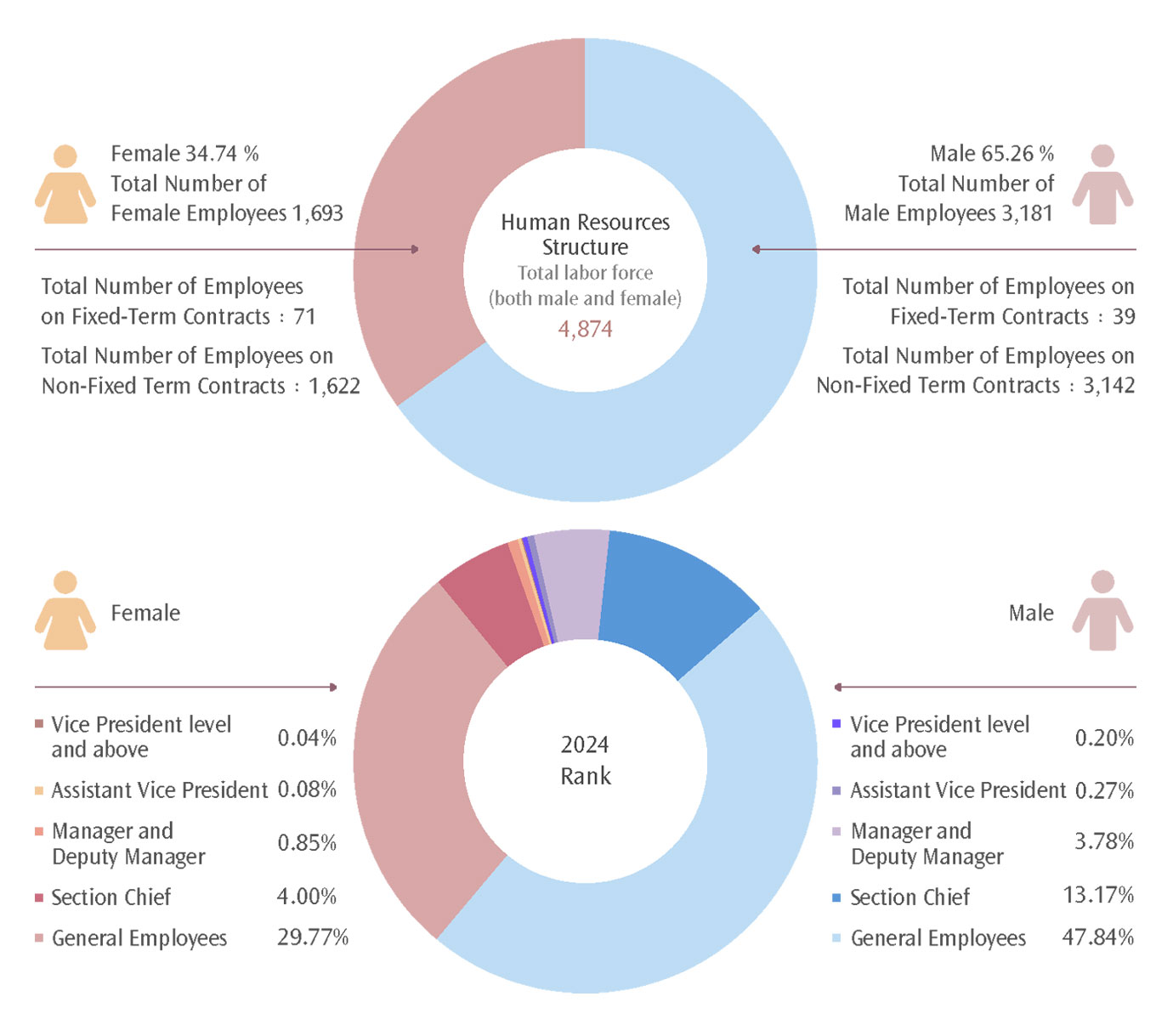
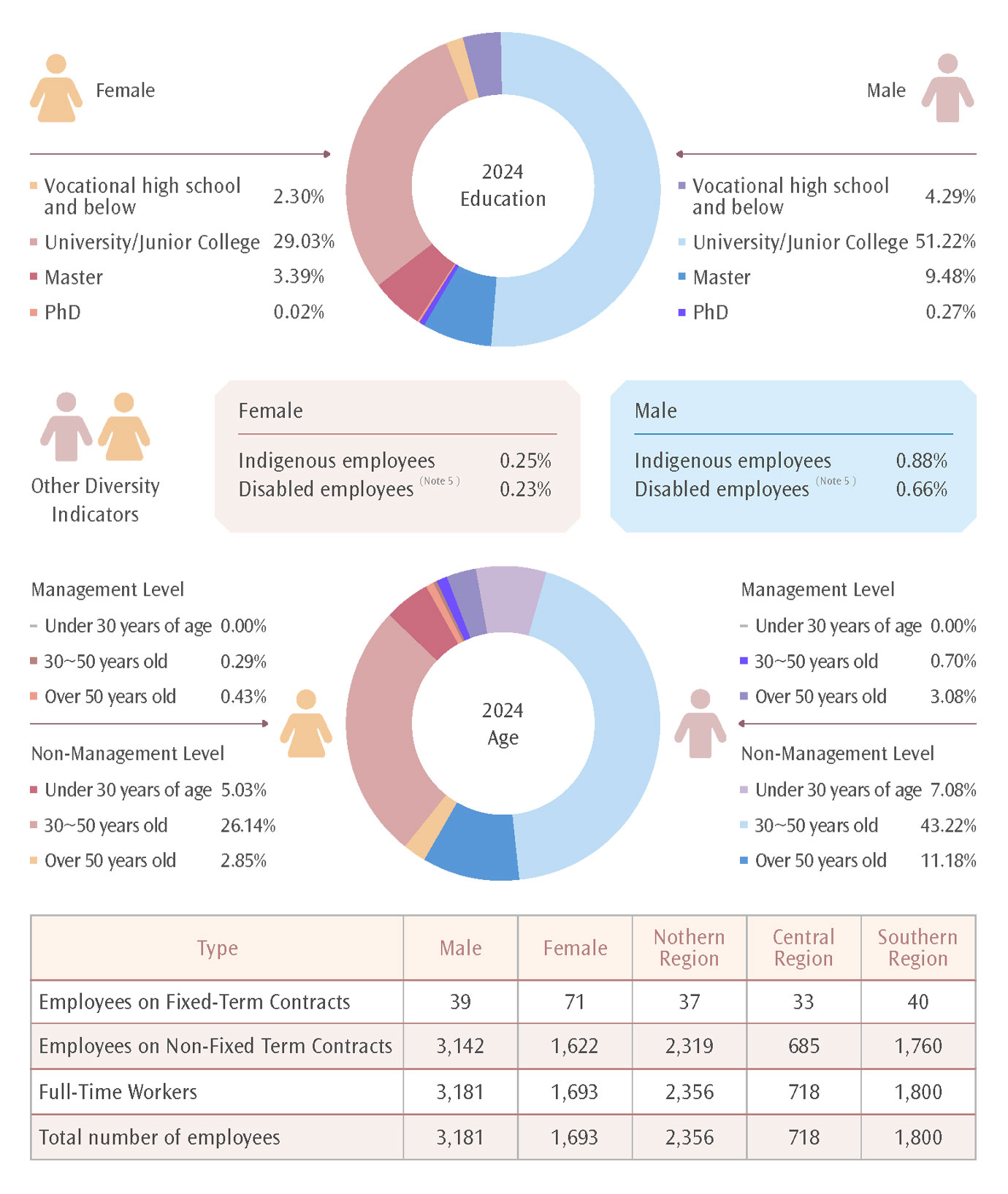
Notes:
1. Fixed-term contract employees are mostly front line interns (including station, service, and maintenance interns).Non-fixed term contract employees are full-time employees.
2. The management level is defined as supervisors of section chief level and above.
3. In 2024, no gig economy, part-time workers or non-employee workers (such as dispatched personnel) were employed.
4. The calculation formula is the number of people in the particular group / Total labor force.
5. The calculation of data on employees with disabilities did not include employees on unpaid leave. In 2024, THSRC employed a total of 43 employees with disabilities, including 9 with severe disabilities, which was higher than the 1% employment requirement as stipulated in the prevailing regulations.Statistics of New Employees in 2024
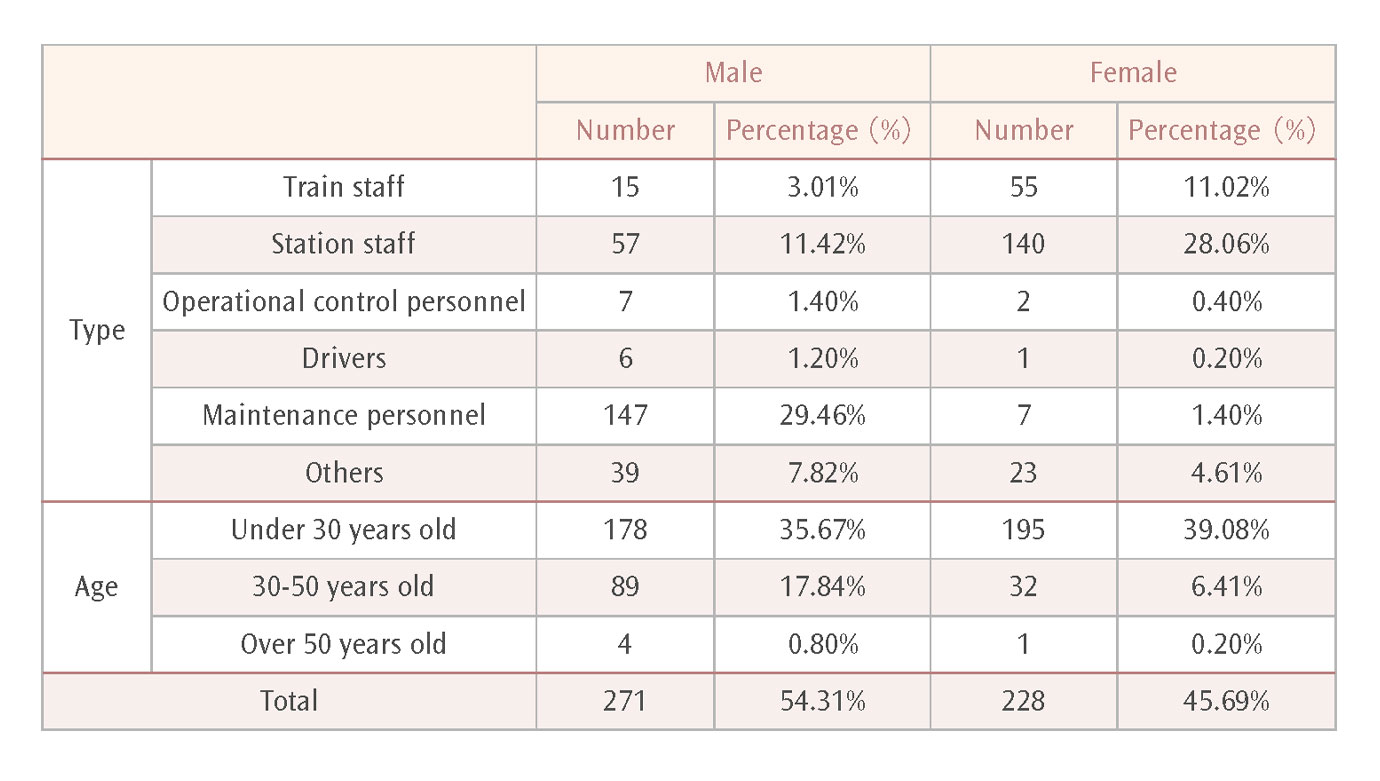
Note: The formula for calculating the new employee rate is the number of new full-time employees in each category in the year / the total number of new full-time employees in the year.
Statistics of Resigned Employees in 2024
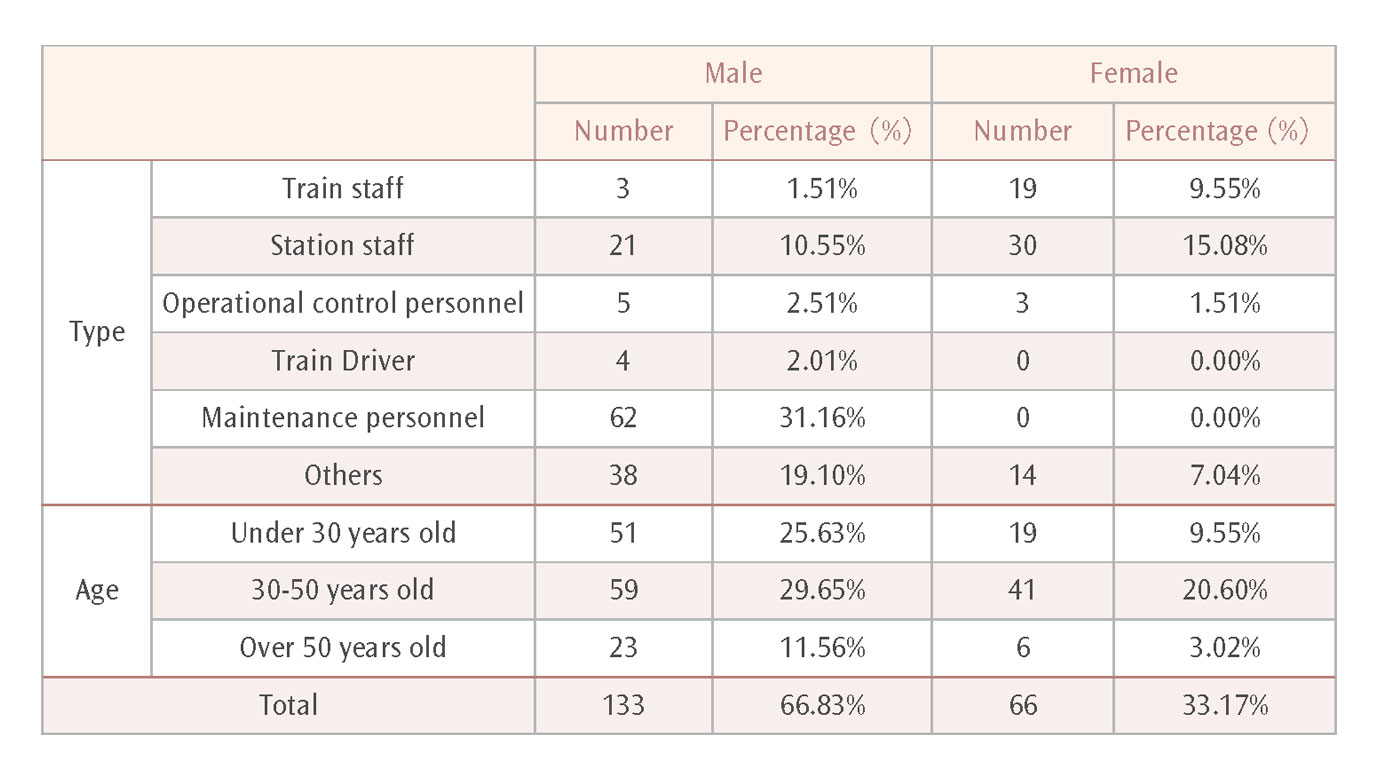
Notes:
1. The formula for calculating the turnover rate is the number of full-time employees in each category who leave the company in the year / the total number of full-time employees who leave the company in the year.
2. Above total number of 199, included 7 deaths (natural deaths) and 20 retirements.
THSRC implements human rights policies, values the rights and welfare of the Company's employees and offers industry-competitive salaries and benefits, regularly reviews the remuneration policy with reference to the results of market remuneration surveys, evaluates the remuneration and related systems for directors and managers, and makes recommendations to the Remuneration Committee and the Board of Directors for approval. Taking into account the rights and interests of shareholders and employee compensation, salary adjustment is carried out to provide industry-competitive salary and benefits according to their work experience, educational experience, expertise and so on but without discrimination based on gender, race, religion, and political position. In 2024, THSRC was ranked as a constituent stock of the Taiwan Employment Creation 99 Index, as one of the top 99 leading companies in terms of the scale of employees in Taiwan.
The starting salary of THSRC junior employees in each job category is higher than the basic salary in Taiwan and does not differ due to gender. As most of THSRC's technical professionals are males, and their salaries are higher than other positions due to the nature of the professional services, there is a difference in the salary ratio of females to males in the general positions, with the ratio of salaries for section chief and managerial staff being comparable; Due to the relatively small number of staff at the Assistant Vice President or Vice President level, and the fact that salaries are influenced by the length of service in that position which resulted in a relatively large difference in the ratio of female to male salaries, but no significant difference, demonstrating the equality of THSRC's remuneration policy. Besides, in order to protect secondees' and contract employees' rights, their salaries are determined and approved by THSRC, and THSRC will inspect manpower agencies' labor contracts and salary-related documents to protect such employees' labor rights.
In 2024, the turnover rate of all THSRC's employees was 4.08%, which was higher than 4.55% in FY2023. This indicates that our efforts to create a happy and fulfilling workplace have been well recognized by employees. We will continue to attract more talent and inject diversity and vitality into the THSRC family. In order to enhance the competitiveness of THSRC talent recruitment and enhance stability of the operation, the Company has increased the starting salary of new employees in specific positions such as maintenance since January 1, 2024, and the “annual salary increase” has be implemented since April 1, 2024. The average salary increases of approximately 4.9%, which has exceeded the previous salary adjustment since 2015, demonstrating the effort of THSRC on sustainability and talents management. THSRC is committed to build a happy workplace continuously to attract more talents and inject diversity and vitality into the company.
Comparison with Basic Salaries in Taiwan

Ratio of Basic Salaries of Females to Males (2024)

Note: THSRC calculates the ratio of basic salary of females to males based on the fixed monthly salary paid to non-fixed term contract employees every month.
In 2024, there were 4,742 full-time non-supervisory employees in THSRC, an increase of 93 people over the previous year. The total salary was NT$5,627,469 thousands, the average salary was NT$1,187 thousands, and the median salary was NT$1,099 thousands. Compared with the previous year, the total salary increased by NT$610,045 thousands, the average salary increased by NT$108 thousands, and the median salary increased by NT$108 thousands.
Information on Salaries of Full-Time Non-supervisory Employees
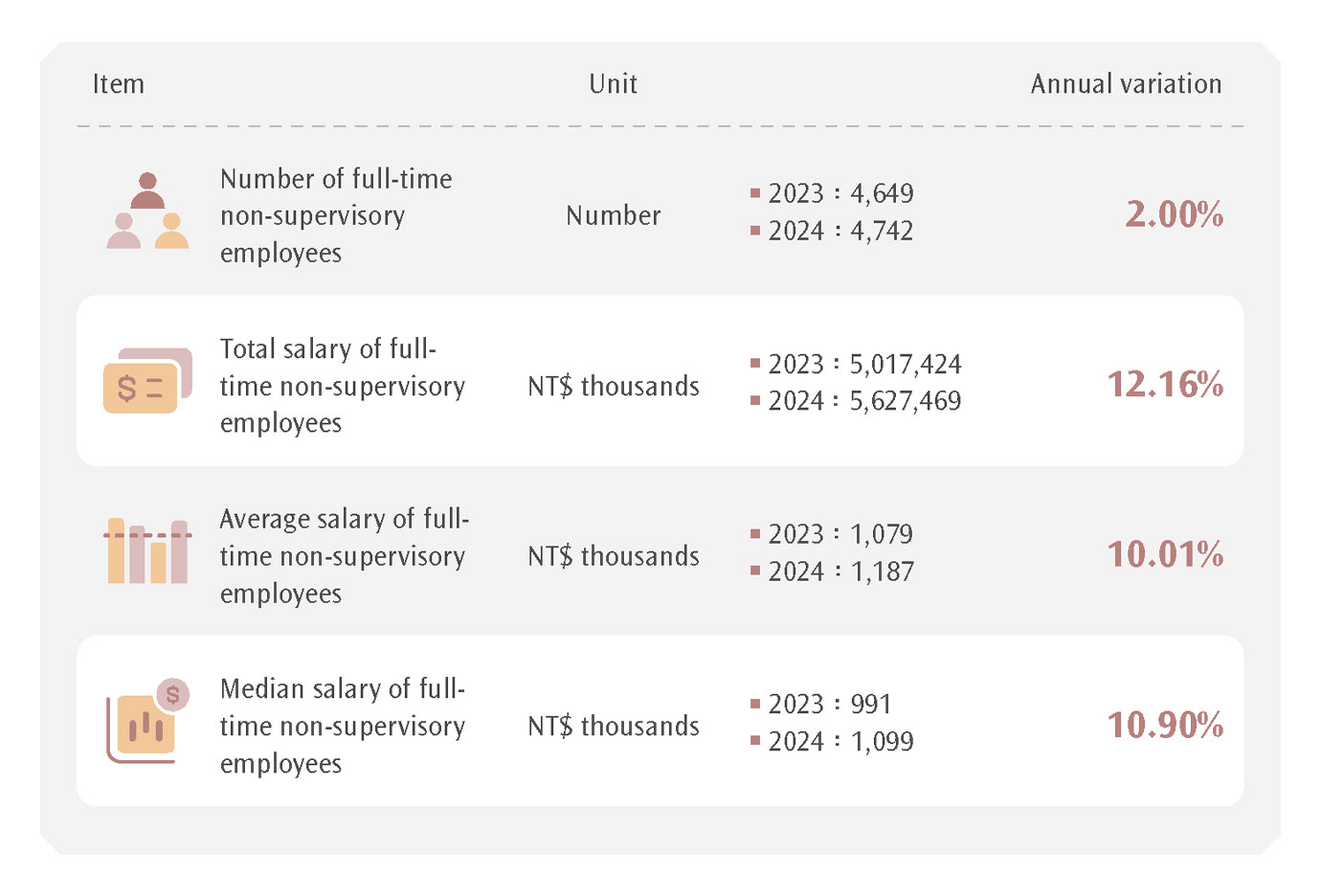
Training Based on Three Major Competencies
THSRC places great emphasis on the development of employee competencies. To ensure the integration of training and practice, the Company plans employee education and training based on two main aspects: “safety” and “service.” THSRC also strengthens the professional knowledge of the three major competencies, namely core competencies, professional competencies, and management competencies. To cultivate professional talents in the transportation industry and stimulate employee enthusiasm for learning, the Company combines multiple learning channels, including external training, online digital courses, and practical exercises. THSRC has established a “Training Management and E-Learning System” and a mobile learning app to effectively monitor the learning process and enhance learning efficiency. In 2024, the number of people who participated in digital learning was 81,112, with an average of 6,759 participants per month. And a total of 447 online courses were offered in 2024, representing a 60% increase compared to 2023.
In order to synchronize employees' career growth with the company's growth, we set up complete functional development blueprint, and provide various training to improve their capability according to different career development stages, covering all colleagues from new comer to supervisors at all levels, with a total of 538 learning courses in 3 major competencies in 2024.
Training Based on Three Major Competencies
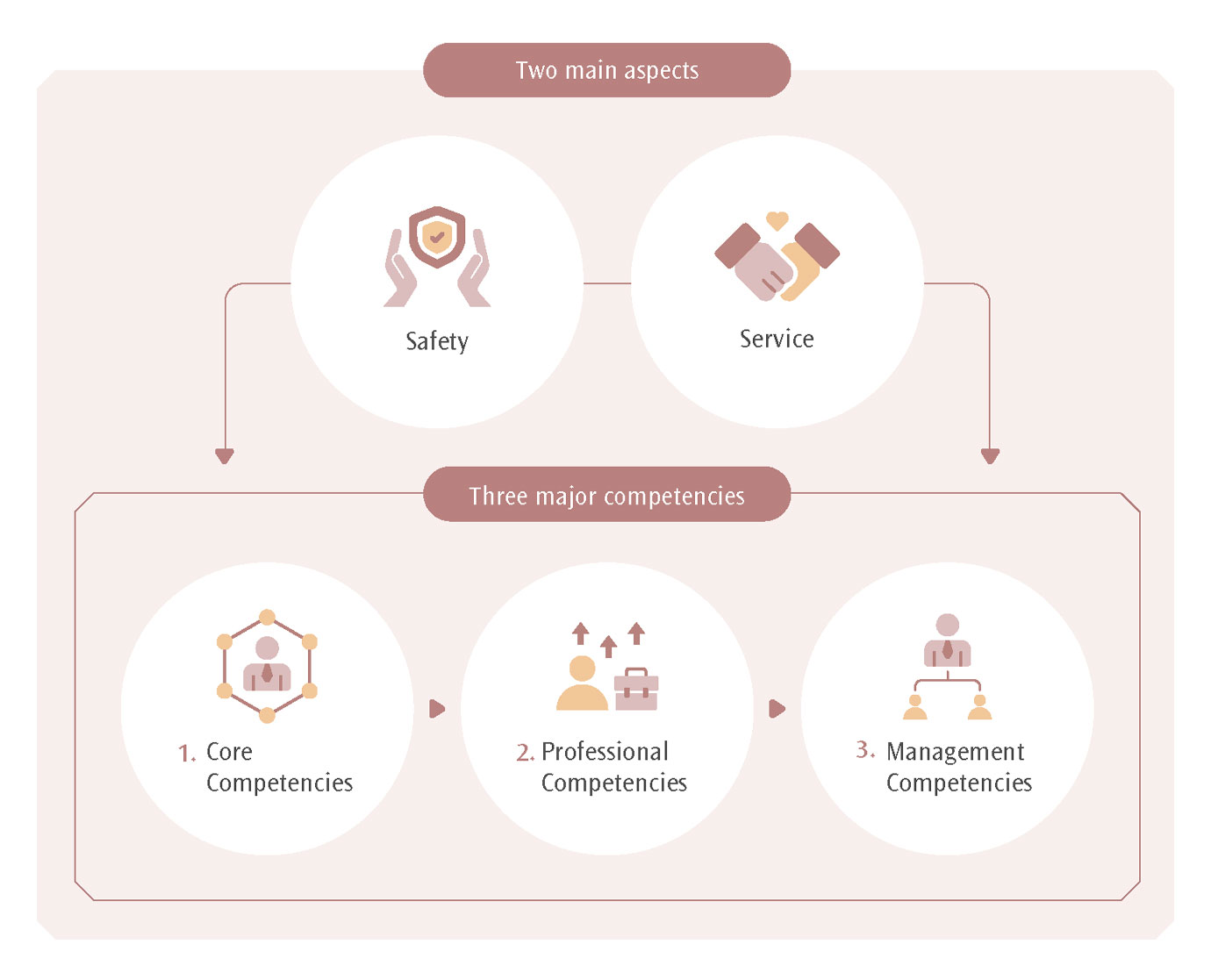
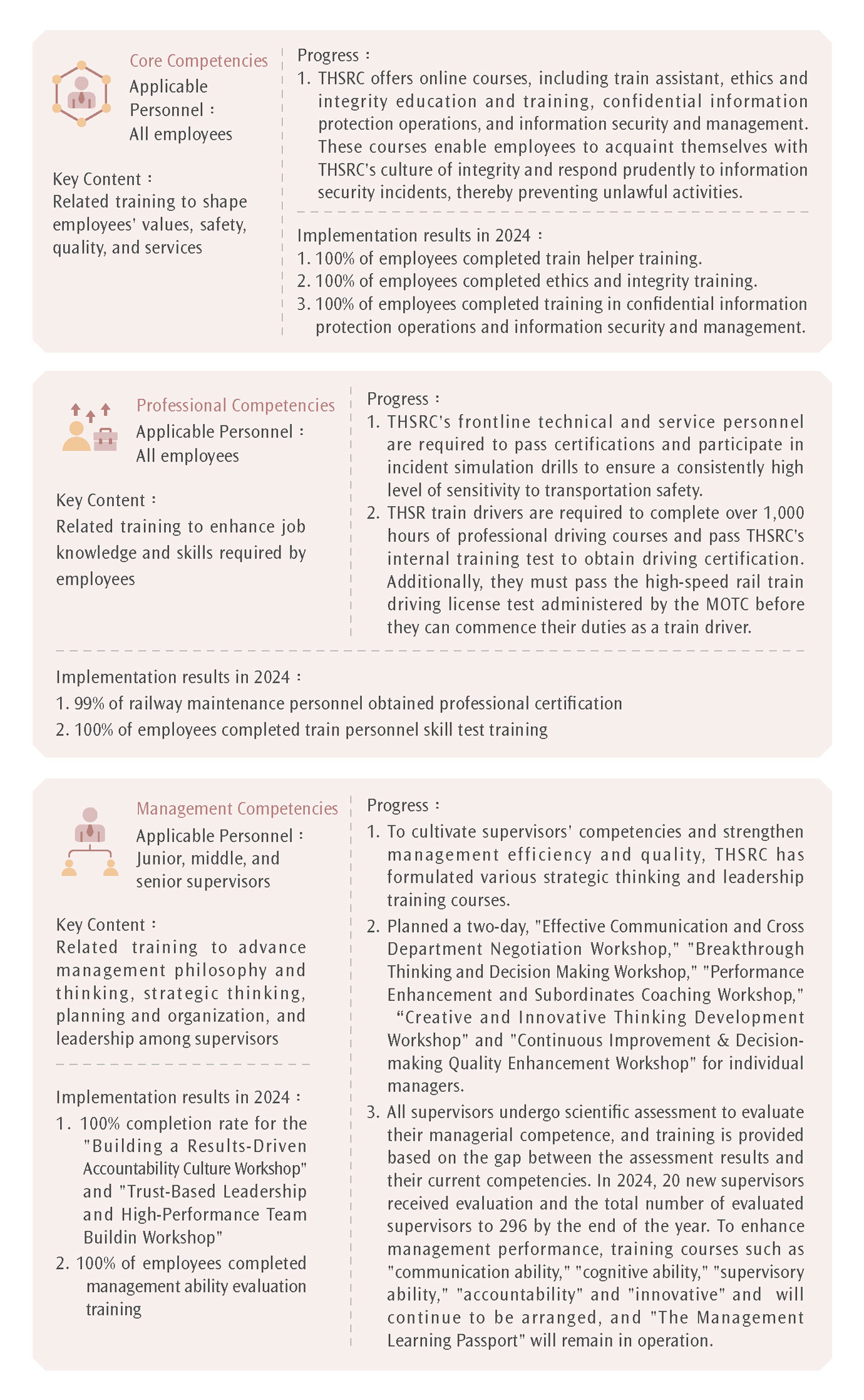
Results of Education and Training Programs
To ensure the effectiveness of internal education and training, THSRC has established a curriculum satisfaction survey mechanism and devised an improvement plan based on the scores. In 2024, the overall employee satisfaction, regardless of training category, was 4.7 points out of 5, demonstrating THSRC's commitment to talent development and its deep trust and recognition among employees. Going forward, THSRC will integrate internal and external resources to enhance the organization's learning ability and employees' self-growth, as well as cultivate their all-round competence.
The table below shows the number of training hours for different ranks and categories of THSRC employees in 2024. Due to the adjustment of annual training items, the number of training hours for new employees and employees in various positions increased compared to 2023:
2024 Training Hours
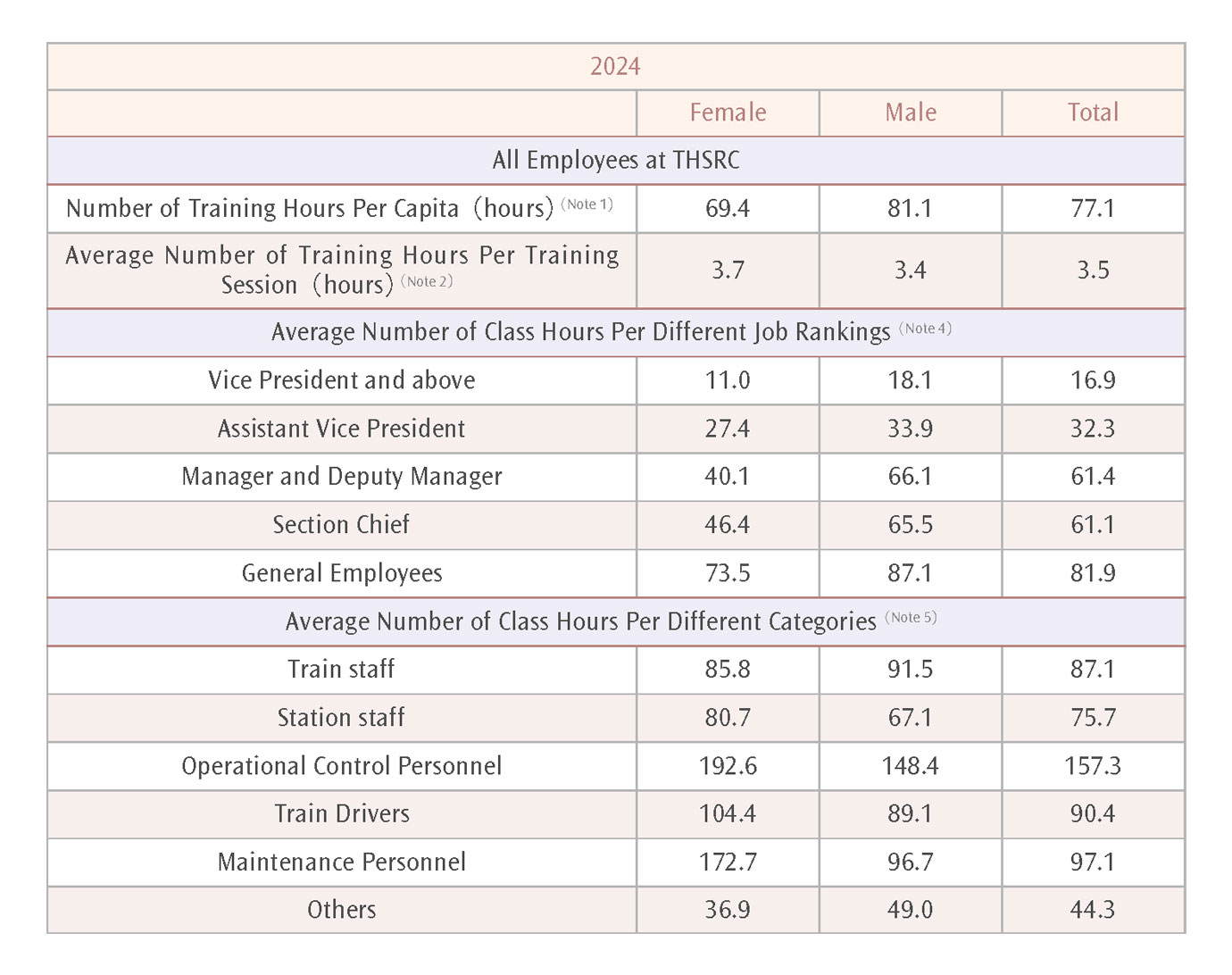
Notes:
1. Training hours per capita = Total training hours 375,555/Total number of trainees 4,874. The training hours per capita of males and females differ from each other mainly because of the ratio of males and females and different professional training attended due to job differences.
2. Average number of training hours per training session = Total training hours 375,555/Total number of training session 107,512. “Average number of training hours per training session” aims to present the number of training hours per training session for each person every year.
3. The calculation encompasses both fixed-term and non-term contract employees. Fixed-term contract employees primarily consist of front-line interns, including station, service, and maintenance interns. Non-term contract employees, on the other hand, are full-time employees.
4. In 2024, the total training hours increased compared to 2023, mainly due to a larger intake of new employees in train service, traffic control, and maintenance positions who were required to undergo professional training.
5. Average number of training hours per different job levels is calculated as: Total number of training hours for a job levels/Number of employees trained at the particular job ranking throughout the year.
6. Average class hours for different categories is calculated as: Total number of training hours for a particular category/Number of employees trained for a particular category throughout the year. For the training hours from 2023-2024, please refer to Table 6 in the Appendices.
To enhance the professional knowledge and technical expertise of THSRC employees and to meet the growing demand for self-provision of professional courses, THSRC is committed to developing internal lecturers in areas such as safety, service, and technical services. These individuals are recommended or selected by senior colleagues or supervisors from relevant units and are qualified as internal lecturers after completing training courses and practical exercises. In 2024, THSRC successfully trained 41 qualified internal lecturers. The training primarily focuses on professional functions, with management functions as a supplementary component. In 2024, the total number of internal lecturer training hours was 345,646, with 983 internal lecturers participating in the courses, average of 352 hours for each internal lecturer.

THSRC has actively signed memorandums of industry-academia cooperation to deepen technology and strengthen the technical strength of the local rail industry through project cooperation and seminars, accelerating the localization of equipment components. In 2024, THSRC completed the development of a programmable signal generator for wind speed, rainfall, and water level, featuring multi-functionality that helps reduce inspection and replacement time and enhances maintenance efficiency. In addition, we proactively established the Pantograph Condition Monitoring System (PCMS) for the 700T trains and collected three months of operational data—including air pressure and vibration—as a reference for future long-term improvement strategies. In the same year, THSRC received an "Outstanding Industry-Academia Collaboration Unit of 2024" by the Chinese Institute of Engineers, and the Chairman was personally honored by the President in recognition of the company's long-term contributions to railway talent development and industry-academia collaboration. In addition, THSRC jointly established a railway equipment laboratory with Kaohsiung University of Science and Technology (TAF certification qualification in 2021), and has developed 37 systems and 4 proprietary instruments so far. THSRC also creates opportunities for young students to explore the railway transportation industry every year. In 2024, THSRC cooperated with 30 colleges and universities to promote internship programs, providing 132 students with internship opportunities in maintenance and transportation jobs.
THSRC's Performance Appraisal Process
THSRC conducts an annual performance appraisal for all employees and supervisors, which determines their ratings based on the appraisal results, assists employees to review their capabilities and performances. Performance interview session has been set up to ensure effective communication between supervisor and employees, to achieve the purpose of feedback, guiding and motivation, as a basis for future career development.
The ratings are classified into five levels, namely “Outstanding,” “Significantly Exceeds Requirements,” “Exceeds General Requirements,” “Meets Requirements,” and “Requires Improvement due to Inability to Perform Existing Work.” Employees who receive the last rating are “required to undergo performance counseling to enhance their work,” and unit supervisors provide necessary assistance and counseling to address the causes of poor performance. In 2024, the total number of full-time employees who underwent performance appraisal is 4,656, with only 5 employees who did not complete their appraisals due to their illness or departure during the appraisal period. The number of completed appraisals accounted for 99% of the total number of appraisals due.
Percentage of Employees Receiving Performance Evaluation by Gender and Age in 2024
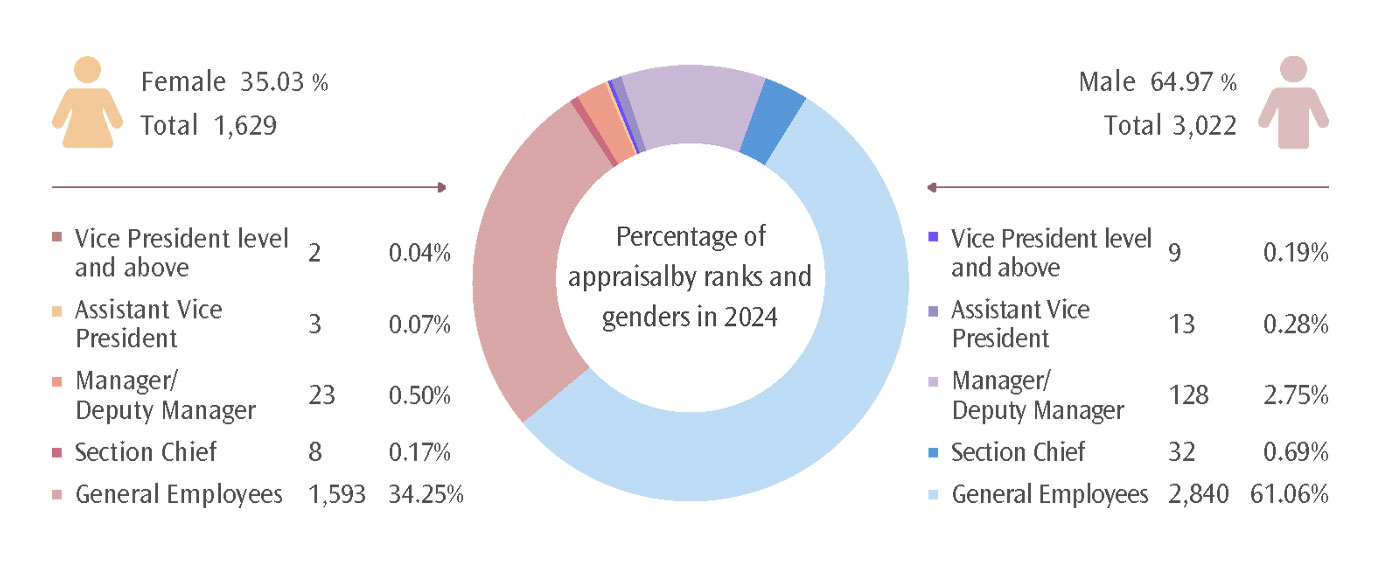
THSRC's Performance Appraisal Process
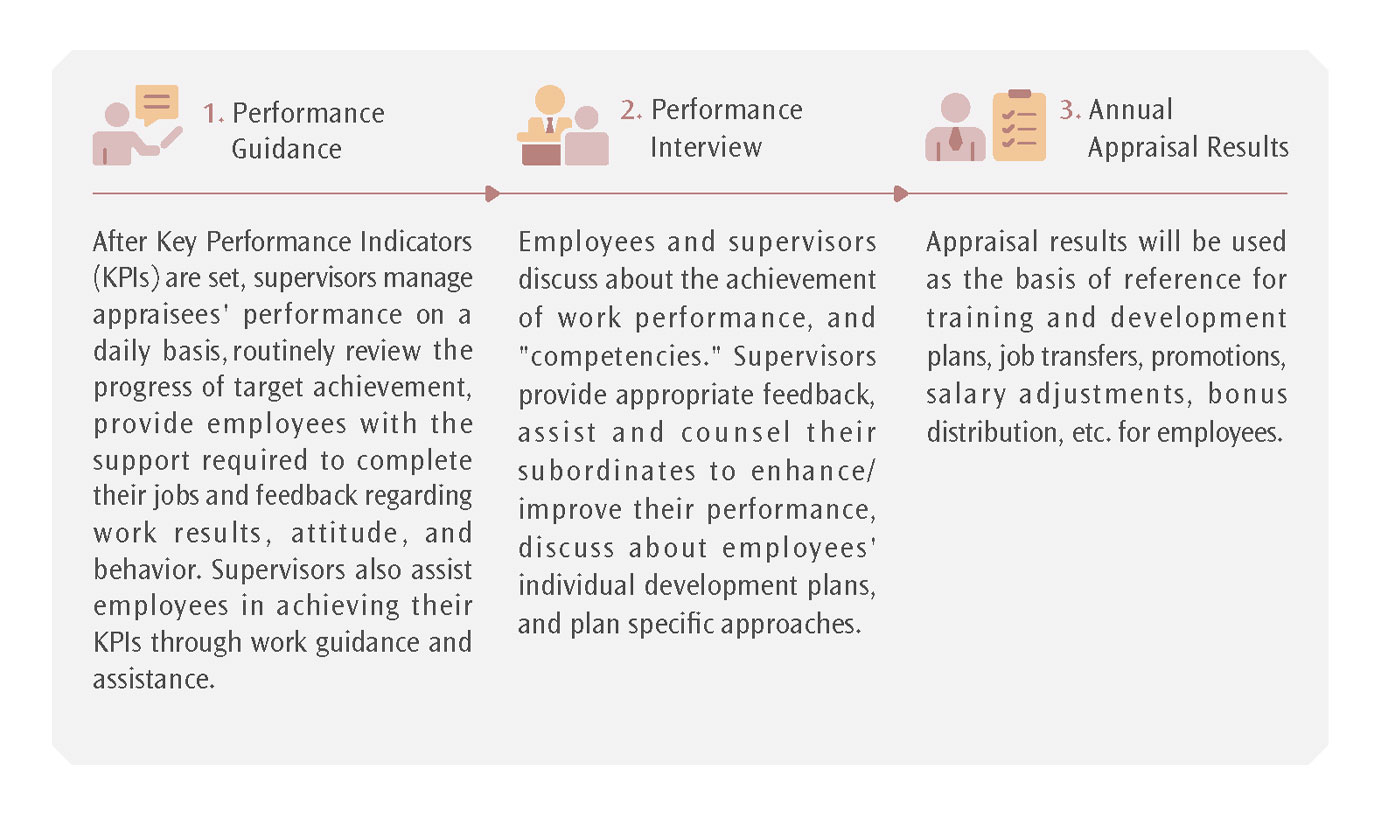
THSRC has implemented the “Career Path” talent development plan, designed different retention and career development paths for outstanding talents in front-line units and colleagues in different positions, and planned relevant manpower allocation based on the annual manpower assessment to meet various business units' manpower needs. Based on organizational needs and personal development, we provide annual promotion opportunities for outstanding talents to achieve the purpose of motivating and retaining talents. For those who are interested in In-charged of management positions and meet the requirements, they can also expand their career path and fully realize their potential through the “Job Promotion” channel.
Starting from 2022, THSRC would plan a specific career development path for maintenance and operation employees, and expects maintenance professionals to learn diversified skills and enhance communication skill through different job experiences, expand future maintenance and operation supervisors, and improve the efficiency of company operations. In 2024, a total of 124 maintenance personnel has been trained, 55 have completed the training, and 69 are still in training. By 2024, we have cultivated a total of 19 station masters, 23 train supervisors, 22 chief controllers, 19 deputy station managers, 21 operation team leader, 19 controller supervisors, 35 station supervisors, and 32 station train controllers, 1 train driver and 3 train controllers.
As the company grows, methods for nurture future successors, build a talent pool and talent echelon is one of the company's important strategies. In 2019, THSRC launched the management capability evaluation project, through scientific evaluation tools, inventory and confirm the gaps between supervisors' management ability and potential, improve all supervisors' management skills and capabilities, and then select high-potential talents, establish personal development plans for cultivating future successors. From 2019 to2024, a total of 296 managers at all levels have been evaluated for their management abilities and develop their learning passports. Several key talent training such as “communication skills,” “cognitive skills,” “supervisory skills,” “accountability” and “innovation” have been carried out based on their lacking competencies.